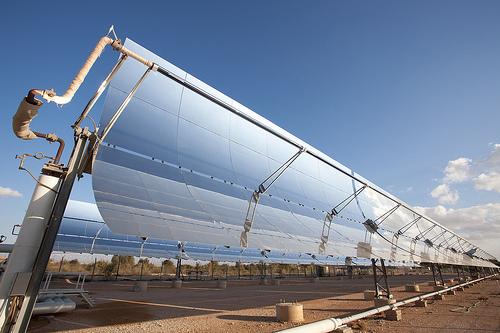Concentrated Solar Power (CSP) has definitely taken a back seat to Photovoltaics (PV) in the last few years when it comes to solar electricity generation, but solar thermal technologies are still far from obsolete.
With PV’s installed price continuing its multi-year decline, there are some questions about the viability of solar thermal technologies. Solar thermal for both residential scale water and space heating as well as utility scale electricity generation were long thought to have better economic potential than PV. As recently as 2008, Home Power magazine was reporting that Solar Domestic Hot Water (SDHW) was paying back 2 ½ times faster than PV for residential use. Then, the installed cost of PV began to drop, and dropped more than 50% between 2007 and 2014. By 2013, Renewable Energy World was reporting that “…household-level solar water heating comes with so many unnecessary drawbacks that it is clear the future lies in another direction. Solar photovoltaic is a highly-effective source for a heat-pump water-heating system.” PV panel prices are so low right now that by most reports it is actually more cost effective to use PV for space heating or hot water than are conventional solar thermal systems.
As for large scale projects, construction of CSP generating stations in the US have all but halted, although the technology seems to be going strong in North Africa and the Middle East. Despite the rapid decline in PV prices and the advances in efficiency, CSP has made advances as well, including new projects that include up to 16 hours of energy storage, allowing CSP plants to make power much more consistently than PV. So why is CSP flourishing in the Middle East and languishing in the US? RP Seigel of justmeans.com reports: “In Arizona, the Solana plant, built by Abengoa … has the additional feature of thermal storage that allows it to provide power through most of the night as well, only without the use of fossil fuels. This accomplishment represents a sort of Holy Grail for renewables, yet, despite this, it’s unclear whether the company will build another one of these, either. In this case, it’s because of uncertainty about the Investment Tax Credit (ITC) which is due to expire at its current 30% level in 2016…”
In addition to the highly politicized nature of the energy sector in the US, it is a simple fact that CSP suits the needs of the developing world better than it does those of highly developed northern nations. Current commercial CSP technology operates best at the high levels of irradiance found in the equatorial and desert regions. Also, CSP can only be done economically on a large scale, so vast stretches of flat, unshaded land are needed. CSP can integrate energy storage, as stated earlier, or it can easily be integrated into a hybrid steam plant that uses fossil fuels as well. This option makes it attractive in many middle eastern countries where oil and natural gas are plentiful. And with the World Banks recent announcement of the launch of the “Scaling Solar” program, we can expect to see CSP plants continue to flourish across the developing nations of the Sun Belt.
Will we ever see a resurgence in the solar thermal business, either large scale or residential in the US, or will PV continue to dominate while solar thermal languishes and eventually fades away? No one can say for sure, but if solar thermal is to make a comeback, it will require the right circumstances. PV prices will need to level out, and solar thermal will need to find it’s new niche. As for PV panel prices, the glut of cheap Chinese panels flooding into the US may be coming to an end in the near future, if the federal government decides to levy a tariff on the Chinese to prevent future dumping. Also, if grid access becomes more difficult, as many utility companies would like to make it, it may make solar thermal look more attractive.
Solar thermal is finding specialty uses in the industrial sector as well. The team of the James S. Markiewicz Solar Energy Facility at Valparaiso University, funded through a $2.3 million grant through the Department of Energy, is nearing its goal to create a commercially viable process of making magnesium using sunlight.
“The team has proven the feasibility of doing this in the laboratory, and now we are preparing to do this in the solar furnace,” said Scott Duncan, Ph.D., Associate Professor, Mechanical Engineering, Valpo College of Engineering. Success could result in a cost-effective manufacturing process in the U.S. that is less harmful to the environment and less energy intensive. Today, most magnesium comes from China and is desirable in the transportation sector because it is 30% lighter than aluminum. In fact, any process that uses large amounts of heat, like kiln-drying lumber and dehydrating food could utilize solar thermal technology.
In the mean time, we can expect to see solar thermals market narrow in the US until the market shifts again.






